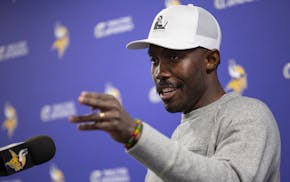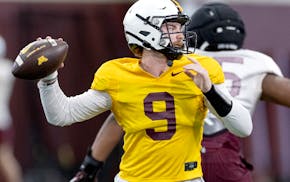A focus on a rash of NHL concussions recently have brought to light many ideas to try to curb the problem: Reinstitute the red line for two-line passes, allow clutching and grabbing again, allow defensemen to fence off at the blue line, remove three or four rows in every arena to make the ice surface bigger.
Kyle Brodziak, the Wild's leading goal scorer, has a novel idea, too.
"You want to eliminate concussions? Tell guys they can't work out anymore," Brodziak said, grinning. "I heard the old Oilers would come in 20 pounds overweight."
Obviously, Brodziak's talking with tongue planted in cheek, but Brodziak's point is NHL athletes are supremely fit, meaning they can supremely fly. And many are starting to wonder if the sport's gotten too fast.
Add the fact NHL players wear equipment -- from lighter, sleeker uniforms that don't absorb as much water, to technologically advanced skates to lighter pads -- that creates more speed, yet they're playing on the same-sized ice surface as always.
"They're doing as much as they can to prevent concussions, but it's a fast game, and bad stuff happens sometimes," Brodziak said. "Everybody wants the game fast. Remember, the goal is to be the biggest, strongest, fastest team."
Hockey is nothing without its players, and more than 30 are out because of concussions, including the Wild's Guillaume Latendresse. Many are big names, such as Pittsburgh's Sidney Crosby, Carolina's Jeff Skinner, Philadelphia's Claude Giroux, Los Angeles' Mike Richards and Ottawa's Milan Michalek.
Flyers future Hall of Famer Chris Pronger's season is over, and his career might be in jeopardy. The Wild's Pierre-Marc Bouchard missed more than a year because of a concussion, and many worried about another after getting his head smashed into a ledge Tuesday in Winnipeg.
On his radio show last week, NHL Commissioner Gary Bettman said, "We know that concussions are a serious issue, and we're doing our best to be very proactive in terms of diagnosis and treatment," Bettman said. "We're not minimizing it, and I'm not disputing it."
Rick Dudley, a longtime NHL exec now working for Toronto, said he thinks this is a problem without an answer.
"The NHL's done what it had to do to take the egregious things from our sport, and it's still happening," Dudley said. "It's a physical, violent game. People will be hurt. Injuries are a part of it. You cannot take the contact out of hockey, or it won't be the hockey you and I grew up enjoying.
"When hockey is fast and physical, like the playoffs, it's as good as it gets in sports. We keep changing the rules, there will come a time where people say, 'What happened to all the contact? What happened to all the intensity?'"
Still, many wonder if you can slow it down. Taking the red line out has created amazing speed through the neutral zone, but maybe there needs to be two-line passes again.
Owners making the rinks bigger at the cost of removing seats ($$$) seems implausible.
"You look at those old games and how slow they were, you think to yourself, 'I could have scored 100 goals,'" the Wild's Cal Clutterbuck said. "But this is the way the game is. It's fast. The game in Europe on bigger ice is a completely different game -- a lot more east-west, twisting and turning. Ours is super fast.
"If you want to eliminate concussions and don't want the risk, you can go play in the Adult Safe Hockey League. They've got a good one in Toronto."
Brodziak doesn't think there's much you can do, but he adds, "It's scary. It's scary because you care about your teammates and losing important guys, but they also have lives after hockey and what will a couple concussions do to you 20-30 years down the road?"

Could the Vikings trade down in the first round of the draft? Here's what their GM had to say.

Gophers QB Pyron, a transfer from Georgia Tech, is re-entering the portal

RandBall: My long history of investing in bad baseball teams
